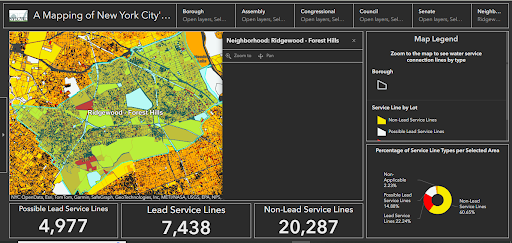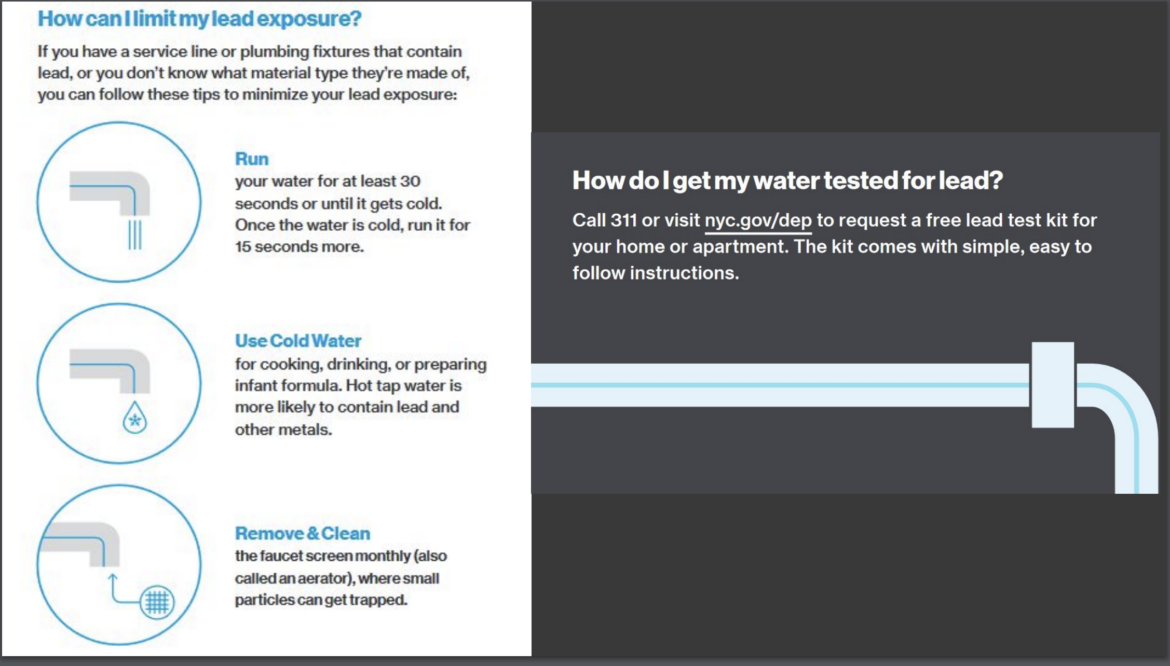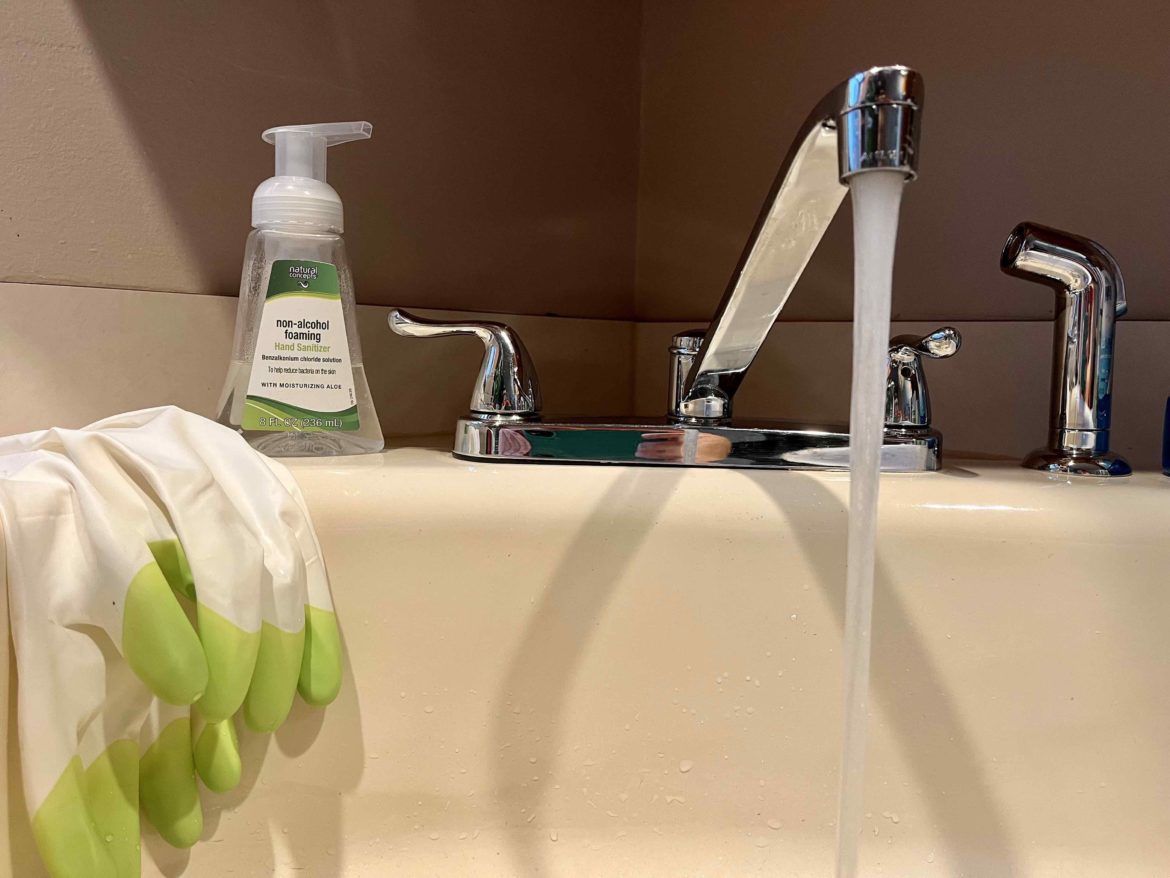New York City has over 124,000 buildings with lead pipes, city data analyzed by the New York League of Conservation Voters shows. Here’s how you can look up your address.

Screenshot/New York League of Conservation Voters
A screenshot of the New York League of Conservation Voters’ new map, displaying homes believed to have lead service lines.
The environmental group New York League of Conservation Voters (NYLCV) launched a map and a report Monday that uses city data to help New Yorkers find out if the pipes that carry drinking water into their homes are made of lead.
Continuous exposure to lead can cause hearing problems, lower IQ, difficulty in learning and hyperactivity. The substance can also slow a child’s development.
One in six New Yorkers, or an estimated 1.3 million people, could be drinking water that passed through a lead or possible lead pipe, the NYLCV’s new study finds.
Their map shows that almost 30 percent of the city’s service lines—the stretch of pipe that connects a building to the street’s underground water supply—are or may be made out of lead. In total, that’s over 124,000 buildings with guaranteed lead service lines and another nearly 125,000 buildings that possibly have them, although city records are yet to confirm their presence.

Screenshot/New York League of Conservation Voters
A screenshot of the map for the Ridgewood neighborhood.
New Yorkers can use the magnifying glass icon on the right hand corner of the map to look up their address, or zoom into their street to see who else on their block has them. By zooming out to the city-wide view, the map pinpoints in white where lead pipe hotspots are concentrated and in purple which areas have them the least.
Until 1961, New York City authorities allowed service lines to be made out of lead. And because they are sturdy, using them was often encouraged or even required.
But the pipes eventually corrode and as pieces flake off, the lead can make its way into drinking water. Now, government authorities know that there is no safe level of lead exposure.
“We worry the most about lead in the brain because the brain cells seem to be a critical organ in terms of sensitivity, especially during periods of rapid development, and that’s early childhood,” said Dr. Morri Markowitz, director of the lead poisoning prevention and treatment program at the Montefiore Children’s hospital.
To avoid contamination, New York City authorities recommend using cold water for cooking, drinking, or preparing infant formula because hot water is more likely to contain lead. They also urge people to remove and clean the screen attached to their faucet monthly, and to hire a licensed plumber to identify and replace any plumbing that contains lead.
Officials say “extensive steps” have already been taken to protect the water supply in people’s homes, including adding food-grade phosphoric acid to create a protective film inside pipes “that reduces the release of metals into the water,” the Department of Environmental Protection (DEP) says.

NYCDEP
The NYLCV hopes its map will also help spread the word.
“We want to make sure that everyone who’s living in a building with a possible lead pipe knows about it so that they can take all those simple precautions to protect themselves,” said Josh Klainberg, senior vice president of the NYLCV.
The pipe-finding problem
To find out if there is lead in drinking water, residents can request a free lead test kit by calling 311 or filling out this form. Here is how to use the test kit once it arrives.
Only one kit per household is permitted, however, and getting them in the mail takes a while, the DEP warns, “due to a high volume” of requests.
Experts also warn that testing the water isn’t always enough when it comes to confirming that a building has a lead service line. Exposure only happens when the water has been sitting in the pipe for more than eight hours—so if the water is tested when exposure didn’t occur, it may not detect a high incidence of lead at all.
“The best way to [confirm the presence of a lead pipe] wouldn’t be through a water test. It would be through a physical or visual inspection,” said Klainberg.
Inspecting the pipes, however, has proven to be a challenge. The service line is considered private property, which means water service providers don’t have the right to check the pipes inside people’s homes. Water providers have been actively trying to find lead pipes by reaching out to consumers. But they rely on a customer’s willingness to let them in, which professionals in the field say doesn’t always work out.
“Everybody’s out of the house during the day, nobody’s home. We leave cards. They get ignored,” said Judith Hansen, former superintendent for the Kingston Water Department and consultant for the American Water Works Association’s New York chapter.
One way to solve this problem, Hansen says, is to pass the state-wide “Find Lead Pipes Faster Act,” a bill that would give water providers the right to inspect pipes.

Jeanmarie Evelly
“This would put a little bit of some teeth behind [our ability to carry out inspections] and actually give us the right to get in there,” said Hansen. “It would make it uniform and give [water providers] the right to all water systems across the state.”
Inspecting more pipes would create a more comprehensive inventory of how many lead service lines exist across the city. Right now, the DEP warns that it cannot “guarantee the accuracy or completeness” of the public data that discloses their location.
To paint a picture of what’s out there, the agency says it relies mostly on historical city records filed by licensed plumbers, observations it has made at water meter readings and data other agencies collected from excavations. It also uses predictive analytics to figure out when there is a high predictability that a building contains a lead pipe.
The NYLCV’s map uses this same data, but gives a city-wide perspective of where the hotspots are and provides different filters so users can isolate the numbers by borough, neighborhood or even by federal, state, and city legislative district.
The environmental group plans to keep updating the map as new information on the whereabouts of lead pipes comes online.
New addresses are sure to pop up as the Lead Pipe Right to Know Act, which was signed into law last year, codified requirements for inventories of lead service lines across the state. The more lead pipes that are uncovered, the easier it will be for policymakers to tackle the massive hurdle of replacing them.
DEP estimates that there will be 150,000 lead pipes in need of replacement when its pipe inventory is completed and it will cost $2 billion to replace them, according to the NYLCV’s report.
And they must replace them: a federal rule that has been in the works since the 1990s was finalized last month, requiring all cities across the country to identify and swap out lead pipes within the next 10 years. Water utilities must also send consumers with known lead services a letter notifying them that these pipes are in their homes.
Last month, Mayor Eric Adams announced that $48 million in grants, provided in part by the Biden-Harris administration’s Bipartisan Infrastructure Law, would help fund a program to replace private lead service lines in low-income neighborhoods.
But there is still much work to be done, NYLCV’s Klainberg warns.
“There is a federal mandate that all the pipes need to be removed, but there’s no mandate for the city to go in and do anything with anyone’s private property,” he said.
“So another purpose of this map is to help educate our partners in government, specifically at City Council, so they can pass a bill to create a lead service line removal program.”
To reach the reporter behind this story, contact Mariana@citylimits.org. To reach the editor, contact Jeanmarie@citylimits.org
Want to republish this story? Find City Limits’ reprint policy here.














